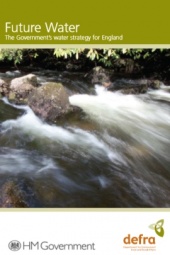Future Water, The Government’s water strategy for England
In 2008, the government published Future Water, The Government’s water strategy for England. The strategy was published as a response to the 2004-06 South East of England droughts and the floods of 2007. It set out the government’s vision for the water sector in 2030 and the measures proposed to help deliver that vision.
In the Foreword, the then Secretary of State for Environment, Food and Rural Affairs, Hilary Benn said:
“In England, the average person uses about 150 litres of water a day – that’s about a tonne a week!... The South East and East of England already face increasing demand on a finite water supply. The drought of 2004-06 was only managed through controls on what we could use water for. This was not a one-off; indeed droughts are likely to be more common. By 2080, some long term climate projections forecast half as much rainfall in summer (nothing like fully offset by 30% more rainfall in winter) in the South East. We need to plan ahead and each of us needs to play our part…. We have, of course, not only to cope with too little water. Indeed the last year has been characterised more by too much water with serious flooding in many parts of the country. Sir Michael Pitt’s report into these floods shows that we still have lessons to learn as a country about defending ourselves from, and learning to live with, floods.”
The document describes ‘...a vision of a sector that values and protects its water resources; that delivers water to customers through fair, affordable and cost-reflective charges; where flood risk is addressed with markedly greater understanding and use of good surface water management; and where the water industry has cut its greenhouse gas emissions.’ This includes:
- The sustainable delivery of stable water supplies.
- Clean water available for nature, people and business.
- An improved and protected water environment.
- An improvement in canals, lakes, rivers and seas for people and wildlife which benefits angling, sailing and other recreational past times.
- Appropriate water charging.
- Action for flood risk through the appropriate use of good surface water management.
- A reduction in greenhouse gas emissions from the water sector.
- An understanding and resilience to climate change including the likely increase in the frequency of droughts and flooding and the rise in population levels.
The document is divided into the following sections:
- Ministerial Foreword.
- Executive Summary.
- Chapter 1 – Future water.
- Chapter 2 – Water demand.
- Chapter 3 – Water supply.
- Chapter 4 – Water quality in the natural environment.
- Chapter 5 – Surface water drainage.
- Chapter 6 – River and coastal flooding.
- Chapter 7 – Greenhouse gas emission.
- Chapter 8 – Charging for water.
- Chapter 9 – Regulatory framework, competition and innovation.
- Chapter 10 – Summary of vision and actions.
[edit] Related articles on Designing Buildings
- Catchment flood management plans.
- Flood.
- Flood and Water Management Act.
- Flood insurance.
- Flood Re.
- Flood risk management plans.
- Flood risk.
- Marine energy and hydropower.
- Pitt Review Lessons learned from the 2007 floods.
- Planning for floods.
- River engineering.
- Sustainable urban drainage systems (SUDS).
- Water engineering.
[edit] External references
Featured articles and news
Professional practical experience for Architects in training
The long process to transform the nature of education and professional practical experience in the Architecture profession following recent reports.
A people-first approach to retrofit
Moving away from the destructive paradigm of fabric-first.
International Electrician Day, 10 June 2025
Celebrating the role of electrical engineers from André-Marie Amperè, today and for the future.
New guide for clients launched at Houses of Parliament
'There has never been a more important time for clients to step up and ...ask the right questions'
The impact of recycled slate tiles
Innovation across the decades.
EPC changes for existing buildings
Changes and their context as the new RdSAP methodology comes into use from 15 June.
Skills England publishes Sector skills needs assessments
Priority areas relating to the built environment highlighted and described in brief.
BSRIA HVAC Market Watch - May 2025 Edition
Heat Pump Market Outlook: Policy, Performance & Refrigerant Trends for 2025–2028.
Committing to EDI in construction with CIOB
Built Environment professional bodies deepen commitment to EDI with two new signatories: CIAT and CICES.
Government Grenfell progress report at a glance
Line by line recomendation overview, with links to more details.
An engaging and lively review of his professional life.
Sustainable heating for listed buildings
A problem that needs to be approached intelligently.
50th Golden anniversary ECA Edmundson apprentice award
Deadline for entries has been extended to Friday 27 June, so don't miss out!
CIAT at the London Festival of Architecture
Designing for Everyone: Breaking Barriers in Inclusive Architecture.
Mixed reactions to apprenticeship and skills reform 2025
A 'welcome shift' for some and a 'backwards step' for others.






















